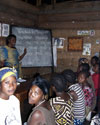
A recent Christian Science Monitor op-ed dug deeper than many diplomats, analysts, and journalists have cared to into the grisly subject of sexual violence in eastern Congo. As co-authors Marc Sommers and Kathryn Birch assert:
[P]robably no war zone in recent times has employed rape as sexual terrorism as extensively as the various military forces [in eastern Congo]… Make no mistake: these are not isolated incidents involving rogue soldiers. This is an organized campaign of sexual terrorism – and the global community must respond forcefully.
Sommers and Birch urge the Obama administration to take bold action—in coordination with the UN Security Council, the African Union, and other international and Congolese organizations—to uphold the principles of human rights and justice for the survivors of sexual violence in Congo. This recommendation is worth highlighting and commending:
[The Obama administration should] press the current mediators for the eastern DRC crisis, former Nigerian President Olusegun Obasanjo and ex-Tanzanian President Benjamin Mkapa, to highlight the issue of eradicating sexual terrorism during deliberations with the main military actors in the region.
Yes, this is what “Inclusive Security” looks like, and this is what Ugandan women’s rights activist Lina Zedriga Waru Abuku means when she says “Nothing about us, without us.” The scourge of sexual violence in Congo will not end until serious, sustained efforts are undertaken to address the root causes of the conflict, and these efforts must include Congolese women at every step along the way.
Also: Listen to this NPR story on Honorata Kizende, a Congolese women’s rights activist who speaks powerfully about “how violence against women is tearing at the very fabric of Congolese society.”

